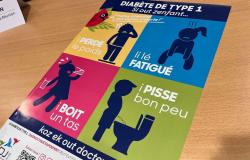
In Reunion, 320 children are affected by type 1 diabetes. Although children develop this form of diabetes every week, delayed diagnosis is still too common, sometimes leading to severe complications. This is why recognizing the signs of type 1 diabetes in children is crucial. Hence the challenge of launching a vast awareness campaign (Photo: www.imazpress.com)
The child will have to take insulin treatment throughout his life.
Diabetes is an autoimmune disease that cannot be prevented or cured.
– Families deprived of their child’s diabetes –
“I saw that my son was losing weight, wet the bed and was thirsty,” confides a mother. “I took him to the attending physician and from there we are given medication to purge him.”
At home, “his condition does not change and he has a wound that does not heal.” “During the night, my son complained of abdominal pain,” says the mother.
That’s when she took her child to the emergency room. “From there, I learned that he had diabetes. The world collapsed, we wondered what we did wrong, if the diet was not good.”
Samuel, Jénaël’s father, discovered his three-year-old boy’s diabetes this year. “He was breathing very badly and in the emergency room the pediatrician said there was nothing.”
“He was peeing but with the diaper on it was hard to see,” he said. “I knew diabetes existed in a child but I would never have thought a three-year-old child could have diabetes.”
Parents who no longer sleep have to adapt for meals but “with time we get used to it because we have no choice”, says the father.
Testimonies which reveal the urgency of better awareness of all.
– Type 1 diabetes, most common in children –
Type 1 diabetes is the most common form of diabetes in children. It is often due to low or no insulin production by the pancreas. It occurs most often in children, adolescents and young adults.
“The patient’s body turns against it. There is an excess of sugars in the patient,” explains Doctor Vincent Appavoupoulé, endocrinologist, diabetologist and head of the diabetology department at GHER. Listen.
The main signs of diabetes starting in children are often overlooked or minimized. These symptoms, which may seem harmless, should however alert you and lead to immediate medical consultation:
● Frequent urge to urinate, often in large quantities
● Resumption of bedwetting in a child who is already clean
● Excessive and persistent thirst
● Rapid weight loss despite a preserved appetite
● Unexplained fatigue
More advanced signs may also appear, such as nausea, vomiting and abdominal pain, often confused with gastroenteritis, delaying diagnosis.
Read also – Type 1 diabetes in children: at the first signs, consult a doctor
– A campaign to change child care –
The Regional Health Agency and the Association of Junior Diabetics (ADJ) are launching a new awareness campaign to encourage the rapid detection of signs of the onset of type 1 diabetes in children: weight loss, frequent cravings for food. urinating, excessive thirst, fatigue…
“This campaign must provide information on the symptoms to prevent the child from presenting at the stage of ketoacidosis to the emergency room, which could have a life-threatening condition.”
This campaign is based on posters and videos aimed at the general public as well as health, social and education professionals. It aims to reinforce vigilance and encourage parents to consult their doctor quickly at the first symptoms.
Find campaign tools on the ADJ974 and ARS La Réunion websites
Early diagnosis is a priority to save lives.
– The Nou’Léla cell to support families –
Since its creation in 2017, ADJ 974 has brought together 260 members and carries out collective actions to support families. Workshops, sports days and conferences allow parents to share their experiences and discuss concrete solutions to face the challenges of the disease.
Aware of the impact of type 1 diabetes on family life, ADJ 974 set up the Nou’Léla Cell in 2020 to offer psychosocial support at home to affected families. This unit provides listening and support in the face of daily challenges linked to childhood diabetes, such as nightly blood sugar checks, interventions in the event of hypoglycemia, and management of stress and fatigue.
The cell also allows families to exchange with other families who have experience of type 1 diabetes, thus strengthening mutual support and resilience in the face of the disease.
This system complements medical support, providing valuable support in the daily management of diabetes, often a source of stress and exhaustion for parents and children.
www.imazpress.com/[email protected]
Health, Diabetes





